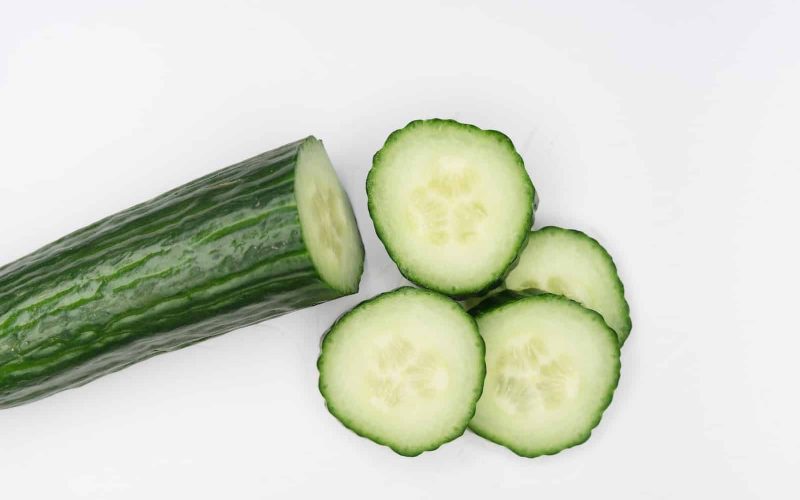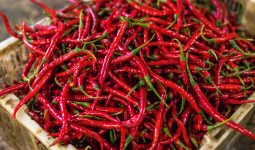Yummy and nutritious, vegetables come in various flavors and colors.
Different types of vegetables are versatile and can be used differently depending on the type.
They are usually categorized based on their edible parts, which are used in cooking.
However, some vegetables can fit into more than one category if different parts of the plant are edible.
This article features the different types of vegetables and their nutritional values.
Vegetables are an important component of a healthy diet.
Different Types of Vegetables
Vegetables can be classified into different types: root vegetables, bulb and stem vegetables, leafy vegetables, and podded vegetables, while some are fruits we consume as vegetables.
The vegetables listed in this article can fall into any of the categories above or even several categories. Read on to learn more about these veggies and their nutritional facts.
1. Broccoli
Broccoli is a cruciferous vegetable that produces green florets. Like many other green vegetables, broccoli is an excellent source of various nutrients.
In fact, broccoli is a vegetable that is so nutrient-dense that it is considered to be a superfood.
For instance, half a cup of cooked, chopped broccoli florets contains nutrients, including calcium, iron, and potassium. The number of vitamins in this broccoli is incredible.
You receive 24% of your recommended daily intake (RDI) for vitamin A, over 80% of your RDI for vitamin C, and a whopping 138% of your RDI for vitamin K!
2. Cauliflower
This is also among the different types of vegetables and belongs to the same category of edible flower vegetables as broccoli, cabbage, and Brussels sprouts.
The cauliflower variant with white florets is the most widely available. The other interesting kinds of this vegetable include orange cauliflower, Romanesco cauliflower, green cauliflower, and purple cauliflower.
In addition, you can eat cauliflower boiled, raw, pan-fried, and, everyone’s favorite, cauliflower cheese. Only 23 calories are present in a 100 g serving of cooked cauliflower.
This cruciferous vegetable has high fiber and low carbohydrate and fat content. It also has sufficient amounts of essential vitamins and minerals.
3. Okra
This is a type of green vegetable where you can eat both the seeds and the pods. The best ways to enjoy okra pods, also known as lady’s fingers, are in stews, soups, and gumbos because they naturally thicken the liquid.
Okra has a high nutritional profile, just like all green vegetables. Also, okra, in its unprocessed state, has only 33 calories and 3.2 grams of fiber per 100 grams.
Okra is a healthy vegetable for people with diabetes due to its low-carb content.
4. Artichoke
Artichokes are also among the different types of vegetables.
Artichoke flowers, which resemble a round ball on top of the stalk, are the edible component of the artichoke plant. This is why it is also known as the globe artichoke.
Artichokes include a lot of vitamins and minerals. The antioxidant content of artichoke flowers may be its most notable nutritional significance.
According to some sources, the artichoke plant is among the vegetables with the highest overall antioxidant content. Antioxidants found in artichokes include apigenin, luteolin, and cynarine.
5. Tomatoes
Tomatoes are an important class of vegetables (or, technically, fruit) that are a staple in most international cuisines.
They come in a wide variety of forms, sizes, and colors. There are little cherry tomatoes, big plum tomatoes, and big beefsteak tomatoes.
When tomatoes are mature, some types are golden yellow, and others are dark green.
Most of the B-group vitamins are also present in tomatoes, along with vitamins A, C, E, and K. All tomato types include some fiber and a modest amount of minerals.
6. Lentils
The different types of vegetables also include vegetables. They’re a type of legume and come in various colors, such as green, black, and red.
Lentils are one of the main sources of plant-based protein in many countries. Raw lentils have 11% dietary fiber and 25% protein.
Of course, you can only eat lentils when it is cooked. The amount of protein and fiber is unaffected by cooking. In fact, lentils are among the top legumes for a high-fiber, nutrient-rich diet.
7. Peas
Peas are tasty and wholesome vegetable seeds that are enclosed in a pod. Some peas, like garden peas, are eaten as seed vegetables without their pods.
However, you can eat pods of other pea types, such as snow peas or sugar peas.
Peas are the top of the list of the smallest, healthiest veggies. You get 5.7 g of fiber, or 22% of your RDI, in a 100 g serving of green peas.
This serving of peas only contains 84 calories, though. Peas are a healthy plant-based protein source, just like beans and lentils.
8. Beans
This is also among the different types of vegetables. Beans are an important variety of vegetable seeds because they are vital sources of plant-based protein.
In addition, Beans come in wide varieties, all of which are tasty to eat. The most popular kinds include cannellini beans, soybean, chickpeas (garbanzo beans), pinto beans, kidney beans, and black beans.
A cup of cooked kidney beans has only 225 calories and an incredible 15 g of protein. Beans are also a good source of minerals. A cup of beans contains manganese, potassium, phosphorus, and iron.
9. Kale
This is a green leafy vegetable that is also classed as a superfood. The nutritional profile of leafy kale has contributed to its popularity as a vegetable.
For instance, a cup of chopped kale has a remarkable 547 mcg of vitamin, 10,302 IU of vitamin A, 80.4 mg of vitamin C (134%), and 1.3 g of fiber (5%).
This green vegetable is incredibly nutrient-dense and only has 33 calories.
10. Lettuce
Lettuce is very popular among the different types of vegetables. Numerous lettuce varieties are ideal for making delicious salads.
Lettuce is a fantastic food to eat if you’re attempting to lose weight because of its high water content and low-calorie count.
In addition, lettuce leaves are a wonderful addition to sandwiches and other meals.
Only 5.4 calories are present in one cup of chopped lettuce. However, you also receive 6.5 mg of vitamin C, 62.5 mcg of vitamin K, and 2,665 IU of vitamin A. In addition, lettuce contains potassium, magnesium, calcium, and iron.
11. Brussels Sprouts
These tiny leafy greens are a nutrient powerhouse packed with fiber, vitamins, and minerals. The amount of fiber in only one cup of Brussels sprouts is 3.3 g or 13% of your RDI.
The amount of vitamin C in this serving of Brussels sprouts is equivalent to 125% of your daily needs.
In addition, these green vegetables have a healthy quantity of protein, vitamin A, vitamin E, and B-group vitamins. Also, Brussels sprouts contain significant amounts of calcium, iron, potassium, and manganese.
12. Spinach
Spinach is a healthy food among the different types of vegetables. It is a nutrient-dense vegetable with numerous health advantages.
One cup of spinach, for instance, provides 108% of your daily recommended intake of vitamin K. Vitamins A, C, and folate are also abundant in spinach.
All necessary minerals are present in spinach in reasonable quantities.
13. Cabbage
One example of a big leafy vegetable that can get as big as a soccer ball is cabbage. There are numerous varieties of cabbage, including savoy, red, and green cabbage.
There are only 22 calories, 5 grams of carbs, and 2.2 grams of fiber in one cup of chopped cabbage. As a result, cabbage ranks among the highest green vegetables in terms of fiber content.
14. Celery
Celery is a good vegetable to snack on and is a low-calorie stem vegetable. It’s also among the different types of vegetables on this list.
According to celery’s nutritional information, a long stalk or stem only has 9 calories. You may nibble on celery without worrying about gaining weight because it is 95% water.
Furthermore, celery also boasts a strong vitamin and mineral profile. A large celery stalk has 23% of your recommended daily intake of vitamin K.
Additionally, you receive a small amount of vitamins A, C, folate, and B6. The majority of essential vitamins are also present in trace amounts in celery.
15. Asparagus
Many people consider asparagus to be the world’s tastiest vegetable. It is a type of green-stem vegetable.
Asparagus has a really impressive nutritional profile, particularly considering its vitamin K level.
For instance, 33 mcg of vitamin K may be found in 5 medium-sized asparagus stems, which is around 40% of the necessary daily amount.
16. Onions
Onions come in a wide variety, and you can use them to flavor cuisine as a bulb vegetable. The onion types include shallots, scallions, and white, red, and yellow.
One hundred grams of a medium-sized onion have 44 calories in them. In addition, onions are a significant source of B-group vitamins and vitamin C. Vitamin K is also abundant in the tubular leaves of green onions.
Various unique antioxidants known as flavonoids are present in this kind of vegetable. These have been demonstrated in studies to help prevent several chronic diseases.
17. Garlic
This is also among the different types of vegetables known for their strong scent and flavor. It is difficult to categorize garlic as a certain type of vegetable.
Some refer to it as a root vegetable, while others refer to it as a culinary herb. The medicinal chemical allicin is found in garlic, the most significant component of its nutritional profile.
This chemical, which is based on sulfur, is antibacterial and anticancer. Additionally, consuming garlic may assist in reducing blood pressure.
18. Ginger
Ginger is a root vegetable that is commonly used as a spice or herb to spice Asian dishes. The main nutritional benefits of ginger are derived from medicinal chemicals known as gingerols and shogaols.
These are potent phytochemicals with antioxidant, anti-nausea, and anti-inflammatory properties.
19. Carrots
Although we typically picture carrots as an orange root vegetable, they come in a variety of other colors as well, just like other different types of vegetables. You may purchase purple, black, red, and yellow carrots.
All varieties of carrots have a similar trait in that they are high in antioxidants. The primary antioxidant in carrots is beta-carotene, which your body uses to make vitamin A.
Carrots come in several types, which are all high in fiber, vitamins, and minerals while low in carbs and fat.
Vitamins A, C, K, and B-group vitamins are present in carrots in good concentrations. Carrots are a fantastic food to consume if you’re attempting to lose weight because they only have 25 calories per medium-sized carrot.
20. Beets
Beets (or beetroot) are another tasty root vegetable that is also incredibly nutritious. The classic dark-purple or red kind of beet is the most widely used.
Beets come in various colors, including pink, striped, and golden. Root vegetables like beets have extremely few calories.
Beets have just 43 calories per 100 grams. Since they have a high fiber content and almost 7% sugar content, beets fall within the category of sweet vegetables. The root vegetable is an excellent source of additional vitamins, minerals, and nutrients.
According to research, juicing raw beetroot can help lower blood pressure. This is so because nitrate is present in beets and helps enhance blood flow.
21. Sweet Potatoes
This is also among the different types of vegetables on this list. Sweet potatoes are a sweet and delicious root vegetable that is incredibly nutrient-dense.
Depending on the sweet potato variety, their flesh ranges from white to dark orange. Sweet potatoes don’t make you fat, which is one of the benefits of eating them.
A medium-sized sweet potato has just 103 calories and almost 4 g of fiber. Sweet potatoes are particularly high in vitamins C and B6 and are one of the best sources of vitamin A.
In addition, sweet potatoes have a lot of beta-carotene, which is its most outstanding nutritional quality. This significant antioxidant is necessary for healthy vision, proper brain function, and a decreased chance of chronic illness.
22. Cucumber
Cucumbers technically belong to the fruit family. However, we mainly consume fresh cucumber as a healthy type of vegetable.
It is estimated that there are over 100 different types of this kind of long, green vegetable. The caloric, fiber, and protein content of cucumbers are low.
However, they are rich in antioxidants and essential vitamins and minerals. To boost your intake of fiber, cucumbers are best consumed with their peels still on.
Conclusion
Vegetables should be a staple of your everyday diet because they are healthy and nutritious.
Knowing the different types of vegetables available will help you plan your meals more effectively and enjoy their many benefits.
Thanks for reading!








